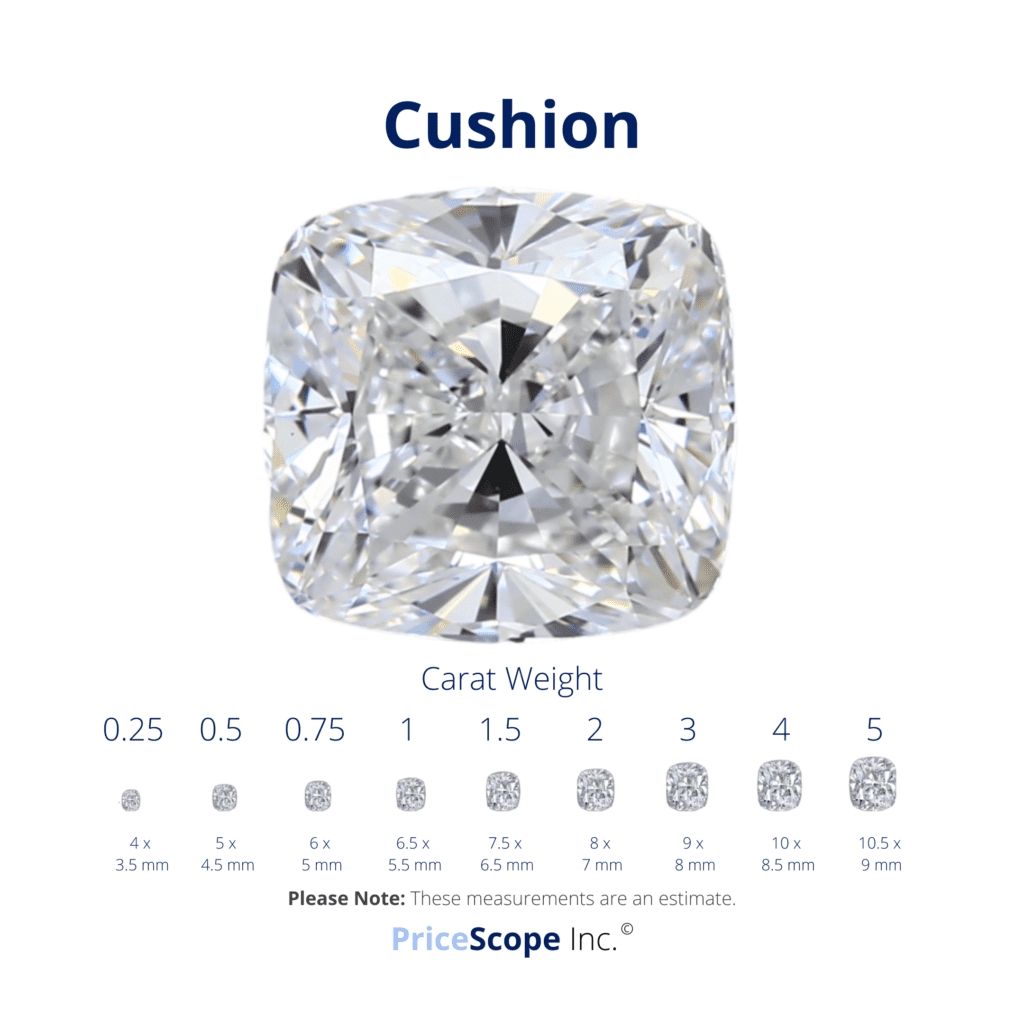Cushion Cut Diamonds – Basics
The cushion cut diamond comes in a variety of shapes, all square or rectangular and reminiscent of a pillow, thus the name “cushion diamond.” There are multiple variations, and personal preference comes into play with any cushion cut diamond decision.
PriceScope Pointer: Most laboratories issue NO CUT GRADE for shapes other than round: If the cut is described as “Ideal” or “Excellent” (etc.) it’s a seller’s description, not a laboratory judgment.
Before going on: Check out the PriceScope Diamond Buying Guide
Cushion Cut Diamond Described
Among the various diamond shapes there are many cushion cut styles on the market, ranging from antique to modern, including some branded cuts which have been optimized for light performance. Antique cushion cut diamonds are known for their steeper crowns, smaller tables, and larger culets. Cushion cut diamonds can be found with a wide variety of facet patterns described as “Cushion Brilliant” or “Modified Cushion Brilliant” on lab reports.

The Fancy, Inconvenient Truth
The typical cushion cut diamond will be cut for heavier weight, at the expense of beauty. This is because many grading laboratories, including GIA, do not assess the optical performance of cushion cut diamonds or other fancy shapes. With no standards enforced, manufacturers tend to plan for the highest yield possible, resulting in cushion cut diamonds of great depth, concealing weight in the body.
Exceptions
The AGS and GCAL assess and grade the optical performance of certain fancy shapes. If you’re seeking cut quality affirmation, fancy shapes with performance deficits will not earn the highest marks from those top-tier laboratories.
tips
Cushion Cut Diamond Selection Tips

Length to Width Ratio
If you’re seeking a square cushion cut diamond, we recommend a ratio between 1.0 – 1.09. If you prefer a subtle rectangle cushion diamond, that can move up to 1.15-1.25.
The 70-70 Rule
When searching for a cushion cut diamond the 70-70 rule advises seeking a cushion diamond which has a table % under 70% as well as a total depth % under 70%. This helps to ensure you’re not paying for a diamond with extra weight in the belly, and ensures a small enough table to foster dispersion.
Other Notes
Personal preference comes into play when considering the cushion cut diamond, because of the variety of appearances available. We recommend that each cushion diamond be assessed on a case by case basis. While we give some broad outlines here, experts within the PriceScope community agree that there are no hard and fast rules when it comes to the cushion cut diamond.
If the cushion cut diamond style employs larger facets inclusions may be easier to see. The variations in facet patterns may also enable the viewer to see color more easily, but this should be judged on a stone by stone basis. For that matter, when it comes to antique cushion diamond styles, some viewers may enjoy the heirloom look of a stone with more color.
Cushion Cut Diamond Prices
PriceScope has been maintaining cushion cut diamond prices charts since 2017 and you can visit cushion cut diamond prices for the latest retail cushion cut diamond price statistics.
Get fast answers to any question: Ask our community of unbiased independent helpers.
Ready to find your diamond?













